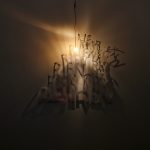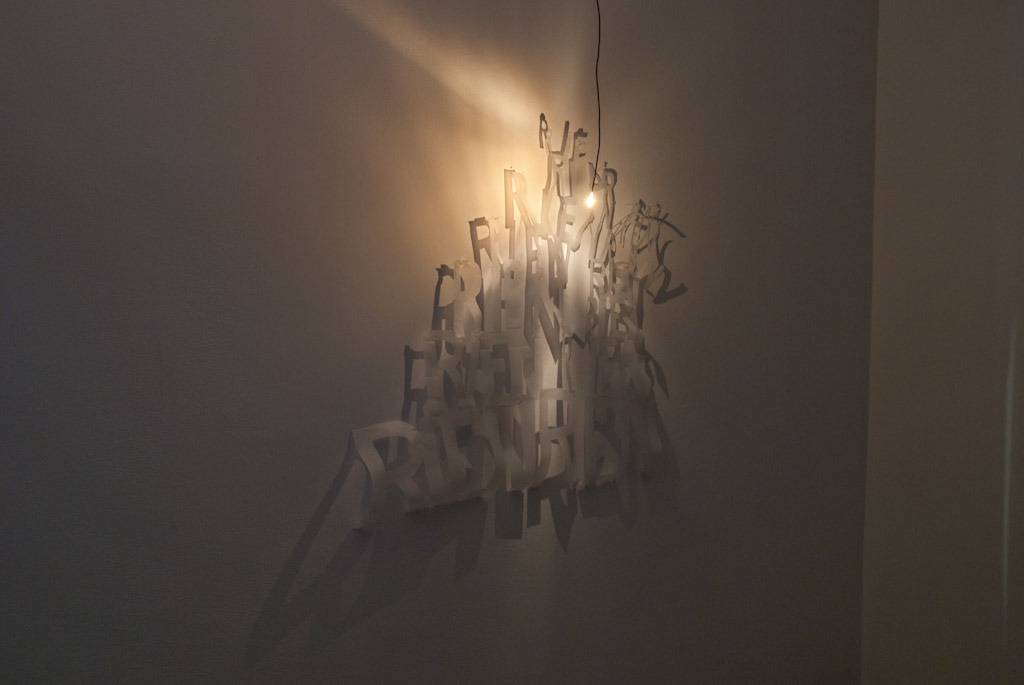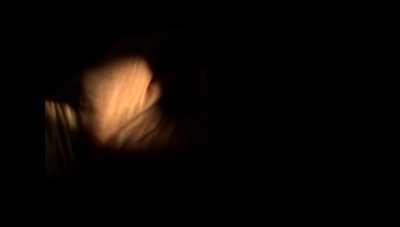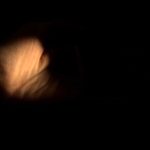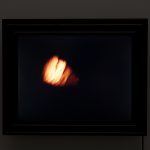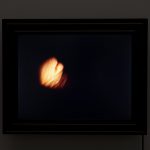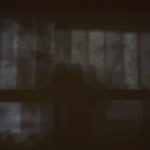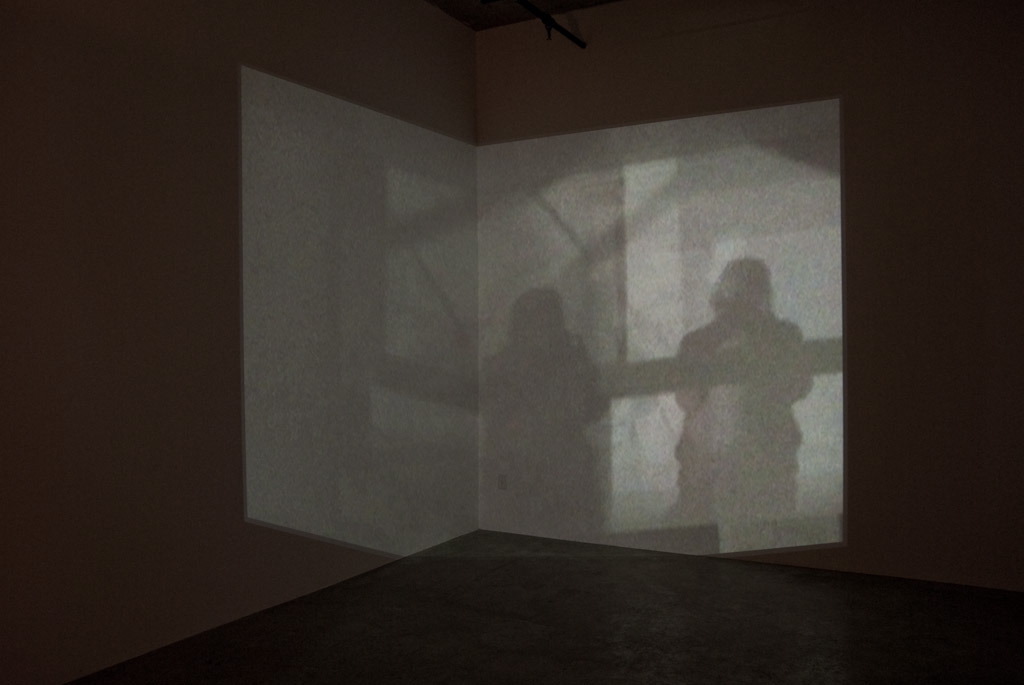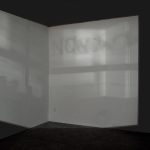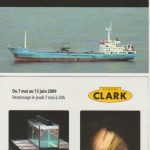Statement
Notions of absence and emptiness as presented by Karen Trask challenge the theoretical charge of these highly referential concepts. Using a pared-down vocabulary in which the colour white has undeniable symbolic significance, the artist addresses the passage of time and the question of our existence over time. Although writing has always been central to Trask’s practice, Histoires de lumières is a video extension of it, requiring the viewer to engage in a reading that is both reflective and contemplative.
Produced during a research residency in Paris, a video projected onto the corner of a wall in the exhibition room shows shadows in motion, filmed in a room on the Seine. The fleeting, fragmented nature of these shadows gives no hint that they are a nocturnal recording of the play of light from the bateaux-mouches that ply the famous waterway. Between these blurred images, an anonymous silhouette regularly appears, standing by a window. These obscure, intangible apparitions, combined with the circular rhythm of the montage and the soundtrack, have the effect of bringing the central theme of the installation to the surface: nothing. This word, in French – rien, multiplied and cut out of a piece of thin white paper, appears on the adjacent wall as a silent, almost transparent reminder of what it’s really about. As the artist points out: “To explore nothing, you need ‘almost-nothing’ means”. It is also in this sense that the capture of evanescent light refers to a presence whose ephemeral nature leads ineluctably to the idea of absence. Another video, which allows us to observe the slow passage of a ray of sunlight across a motionless palm, suggests, with measured poetry, a form of causality between light, duration and erasure. Taken as a whole, Trask’s installation calls for a philosophy of the present.
Aseman Sabet, 2009 | Translation: Karen Trask
—
Le regard que pose Karen Trask sur les notions d’absence et de vide met à défi la charge théorique de ces concepts hautement référentiels. À travers un vocabulaire épuré, au sein duquel la couleur blanche a une indéniable portée symbolique, l’artiste aborde le passage du temps et investit la question de l’existence dans la durée. Si l’écriture a toujours été centrale dans la pratique de Trask, Histoires de lumières en propose une extension vidéographique exigeant du spectateur une lecture à la fois réflexive et contemplative.
Réalisée lors d’une résidence de recherche à Paris, une première vidéo projetée en coin de mur dans la salle d’exposition présente des ombrages en mouvement, filmés dans une chambre à proximité de la Seine. Le caractère fuyant et fragmenté de ces ombres ne laisse en rien deviner qu’il s’agit de la captation nocturne du jeu de lumière des bateaux-mouches qui parcourent le célèbre cours d’eau. Entre ces images troubles, apparaît régulièrement une silhouette anonyme, debout près de la fenêtre. Ces apparitions obscures, intangibles, combinées au rythme circulaire du montage et de la bande sonore, ont pour effet de remettre en surface le thème central de l’installation : le rien. Ce mot, multiplié et découpé dans une pièce de fin papier blanc, figure au mur adjacent comme un rappel silencieux, presque transparent, de ce dont il est réellement question. Comme le souligne l’artiste : « Pour explorer le rien, il faut des moyens “presque-rien” ». C’est également en ce sens que la capture de la lumière évanescente renvoie à une présence dont le caractère éphémère conduit inéluctablement à l’idée d’absence. Permettant d’observer le lent passage d’un rayon de soleil sur une paume de main immobile, la dernière pièce vidéographique nous suggère, avec une poésie mesurée, une forme de causalité entre la lumière, la durée et l’effacement. Prise dans son ensemble, l’installation de Trask évite les détours et appelle une philosophie du présent.
Aseman H Sabet, 2009
—
For a residency in Paris in 2008, I proposed to research and explore the idea of nothingness, and to find ways of representing nothing using my own writing as a tool for exploration. In the past, the empty page and whiteness has been a metaphor I often used to represent absence and nothingness.
After several years of intense work with process and materials, I felt the need to challenge myself with something very different. Once in Paris, I decided to reduce my parametres for creating to a bare minimum and to simplify the process as much as possible. I wanted the results to be ephemeral, barely visible – the rawest possible. An intersecting of time and space seemed to be the essence. Nothing in my creative process happens this rationally nor this directly, things come together more often in a jumble of trial and error.
Two works in Histoires de lumières were created in my studio, overlooking the River Seine and the busy road between it and the river. Each night, the tourist-filled bateaux-mouches went down the river shining their very bright lights into my room, making a magical and monumental movement of light and shadow. I remembered as a child watching from my bed, the lights of passing cars from sometimes quite far away enter my room and touch all of the walls before exiting and disappearing down the country road. I began to video document the light and shadows moving in my studio. Histoires de lumières, the work from which the exhibition takes its title, documented the light. I saw my studio as the interior chamber of a camera and there, from inside, I was able to watch the light from this – the City of Lights enter and travel through this interior space.
Speed of Light is a movement of the sun across my hand. Often inspired by personal experience, I understand my work as part of an autobiographical process where I observe myself observing and interacting with the world. This work is simply that.
Karen Trask, 2009

